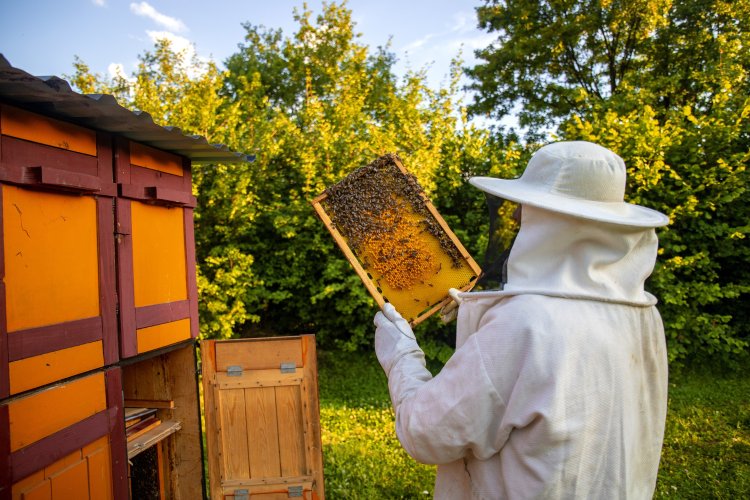Smart Beehive Monitoring System: The Role of IoT in Modern Beekeeping and Bee Health Management
Discover how IoT-powered beehive monitoring systems are transforming modern beekeeping. Learn about bee health tracking, honey bee population decline, and safety tips for relocating hives.
Share this Post to earn Money ( Upto ₹100 per 1000 Views )

Introduction
Beekeeping has long played a vital role in agriculture and biodiversity. However, the 21st century brings new challenges: environmental changes, diseases, and the alarming decline of honey bee populations. Enter the Beehive Monitoring System, an innovative solution powered by the Internet of Things (IoT). This blog dives deep into how IoT is saving beekeeping, explores methods of modern beekeeping, and explains how smart sensor technology is used to monitor bee health. Additionally, we shed light on the declining honey bee population and share exclusive safety tips for moving beehives.
The Role of IoT in Saving Beekeeping
The Internet of Things (IoT) connects devices and sensors to a central platform that collects, transmits, and analyzes data. In beekeeping, this means embedding hives with sensors that track temperature, humidity, hive weight, sound, and even bee movement.
Key Benefits of IoT in Beekeeping:
-
Real-time data monitoring: Beekeepers can access hive data remotely through mobile apps.
-
Early problem detection: Abnormalities in hive temperature or bee activity can indicate health issues, swarming, or environmental threats.
-
Automated alerts: SMS or push notifications alert beekeepers to immediate problems like theft, predator attacks, or ventilation issues.
By offering actionable insights, IoT helps prevent hive collapse and improves the productivity and longevity of bee colonies.
Methods of Modern Beekeeping
Gone are the days when beekeeping relied solely on manual inspections. Modern beekeeping methods combine tradition with technology to enhance efficiency and sustainability.
Innovations in Beekeeping:
-
Smart Hives: Equipped with temperature, weight, and motion sensors.
-
Remote Hive Monitoring: Track conditions using cloud-based dashboards.
-
AI Integration: Predict swarming behavior, detect disease patterns, and forecast hive productivity.
-
Automated Feeders: Control sugar syrup dispensing based on bee activity levels.
These tools reduce the need for frequent hive disruptions, lowering stress on bees and reducing beekeeper workload.
Monitoring Bee Health by Smart Sensor Technology
One of the most impactful uses of a Beehive Monitoring System is the ability to monitor bee health using smart sensor technology. Healthy hives are productive hives. Smart sensors help ensure just that.
Health Parameters Monitored:
-
Temperature and Humidity: Ideal internal hive temperature (approx. 34–35°C) is crucial for brood development.
-
Hive Weight: Monitors food stores and honey production.
-
Sound Frequency Analysis: Microphones detect changes in buzzing, which can signal swarming or queenlessness.
-
CO2 Levels: Elevated levels may indicate poor ventilation or overcrowding.
Continuous health monitoring allows for immediate interventions, reducing the risk of disease and collapse.
Exclusive Information About Honey Bee Declination
Honey bee population decline is a global concern. According to research and beekeeping organizations, beekeepers in some regions report colony losses exceeding 40% annually.
Major Causes of Decline:
-
Pesticide exposure (notably neonicotinoids)
-
Varroa mite infestations
-
Habitat loss and monoculture farming
-
Climate change
-
Nutritional stress
The integration of smart monitoring systems can help mitigate these issues by providing timely warnings and enabling proactive management strategies.
Example:
If a hive’s temperature drops significantly, it may indicate the queen has died or that the colony is weakening—early detection can save the hive.
Best Safety Tips for Moving Beehives
Relocating bee hives is often necessary for pollination contracts, seasonal changes, or safety reasons. However, moving a hive is risky if not done correctly.
Scrutinize These Safety Tips for Moving Beehives:
-
Plan for Cooler Weather: Move hives in the evening or early morning when bees are less active.
-
Secure the Hive Properly: Use ratchet straps and foam to prevent frame movement.
-
Use Smoke Cautiously: Calm the bees before sealing the hive entrance.
-
Close Entrances Tightly: Prevent bees from escaping during transport.
-
Avoid Long Distances in One Go: Rest stops help regulate hive temperature.
-
Monitor After Relocation: Use IoT to check hive conditions post-move and reduce colony stress.
Incorporating smart sensors during relocation provides peace of mind and helps assess the immediate impact of the move.
Highlighting the Primary Content
The core of this blog centers around the Beehive Monitoring System and how IoT is transforming modern beekeeping. These technologies enable:
-
Efficient monitoring of hive health
-
Proactive responses to environmental threats
-
Better productivity and bee welfare
-
A sustainable future for apiculture in the face of declining bee populations
By combining modern beekeeping methods, smart sensor technologies, and real-time data, beekeepers can adopt a more sustainable, data-driven approach.
Final Thoughts
As environmental challenges increase and bee populations continue to decline, technology becomes not just an enhancement but a necessity. The Beehive Monitoring System and the exclusive role of IoT in saving beekeeping are paving the way for a smarter, more resilient future in apiculture.















